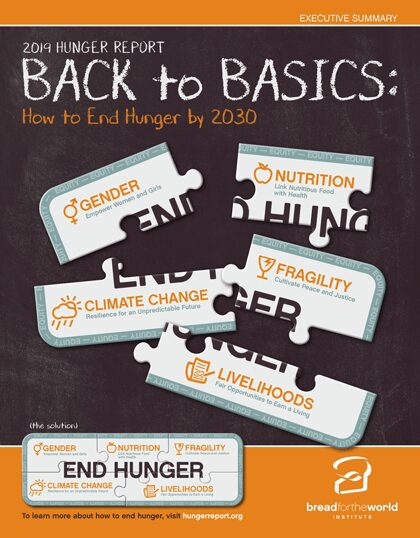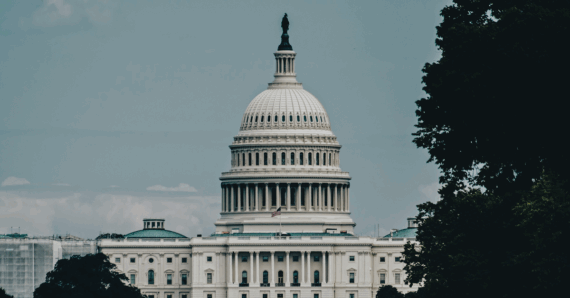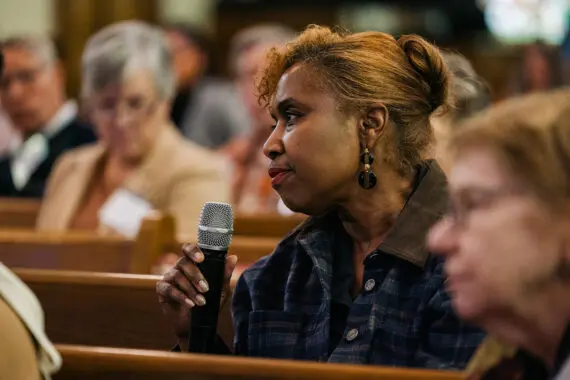Gyude Moore: Building Bridges to Peace in Liberia
Currently Moore is a visiting fellow at the Center for Global Development, where Hunger Report Senior Editor Todd Post met with him to talk about advocacy and foreign aid. As Minister of Public Works, his focus was entirely on infrastructure, he said, and since leaving the government, he finds it hard to let the subject go.
He told a story about being on a rural road in Liberia and coming to one of the many bridges that had been destroyed during the war years. “When we got to a bridge, we had to arrange planks to get the car across. Everyone got out except the driver, and we walked across after he safely piloted the vehicle over the planks.” It was a hair-raising experience. The Liberian countryside is littered with abandoned vehicles, half submerged under bridges, whose drivers had attempted similar crossings.
As they were negotiating the crossing, a motorcycle driver drove across as well. His passenger was a pregnant woman on her way to the health clinic. Liberia has one of the world’s highest rates of maternal mortality. Moore pointed out that many women don’t seek medical care because so many roads and bridges are badly damaged or simply impassable. Particularly where bridges have been destroyed, a clinic that might have been a two-hour journey in the prewar period could now take an entire day.
The woman on the motorcycle, a smallholder farmer, told Moore that the condition of the bridge was the reason she didn’t sell her products at a larger market where she could earn more. In another part of the country, where Moore oversaw a road improvement project, farmers did gain access to new markets, and as a result, their sales increased.
Infrastructure creates opportunities that people in poverty are eager to seize. Liberia is one of many African countries with a large youth population in search of work. Moore said that how successful the country is in repairing and developing its infrastructure will, to a large extent, determine how successful it is in unlocking the economic potential of its youth.
A crucial part of a country’s infrastructure is electricity. When President Johnson Sirleaf was sworn in, the country’s only source of electric power was diesel generators. Moore said that on game days, the average football stadium in the United States consumed more energy than was being produced in all of Liberia. Liberia signed a contract with the U.S. Millennium Challenge Corporation (MCC) aimed at rebuilding its power infrastructure. MCC offers multi-year grants to countries that meet governance criteria such as combating corruption and investing in health and education. More than half of MCC’s financial support is used for infrastructure development. In Liberia’s equivalent of the State of the Union, Johnson Sirleaf explained to the public how her administration was tackling corruption and working to meet other MCC criteria. Moore noted that Bread was advocating for the creation and full funding of the MCC when he served as an organizer in 2003-2004.
Lately, Moore has been thinking about another infrastructure challenge that Liberia faces along with other low-income countries: weather forecasting. The World Bank is funding a project in sub-Saharan Africa to create a large, comprehensive network that could provide timely local weather forecasts. This is particularly important for countries and regions that are enduring the increasingly severe impact of climate change. Weather alerts would warn shepherds to move to higher ground. A storm that washes away fertilizer could be the difference between a farmer’s profitability and hunger, so it would be extremely helpful to know when to delay putting down fertilize for a day or two. People about to take their boats out to fish early on a sunny morning would know about a strong afternoon thunderstorm and return to shore in time.
When Moore reflects on the critical role of U.S. foreign aid in his country, he notes that the United States is the largest donor to the World Bank, and he praises Bread for the World and other civil society groups for making U.S. citizens aware of the progress against hunger and poverty that U.S. development assistance helps make possible in Liberia and in other developing countries.
This advocacy impact story is part of Chapter 5: Fragility.
Sign Up
Get periodic emails with more resources about the issues discussed in the Hunger Report
Print or Download Report Materials

2019 Hunger Report Executive Summary
Ending hunger is within reach. 2030 sounds audacious. But decades of victory over hunger, despite recent setbacks, reveal a different picture. It is rapid global progress, not any one which persuades us that ending hunger and malnutrition is possible sooner rather than later.
Christian Study Guide
The study guide offers a biblically-based tool to explore God’s call to protect vulnerable people in the 21st century. The guide summarizes the report’s overall themes and provides discussion questions and group activities on select topics in the report.
Introduction: Ending Hunger is Within Reach
A national effort to end hunger could bring our country together and this goal has in fact, already brought the world together. Ending hunger and all forms of malnutrition by 2030 is one of the Sustainable Development Goals (SDGs) adopted in 2015 by the governments of 193 countries, including the United States, with support from their civil society and business sectors.
Chapter 1: Livelihoods
The only way to end hunger with dignity is to enable people to earn the income they need to provide enough healthy food for themselves and their children.
Chapter 2: Nutrition
Maternal and child nutrition is a critical factor in healthy human development. Nutrition is a lifelong necessity for the health and well-being of individuals, their communities, and ultimately their countries.
Chapter 3: Gender
Women in every society are treated as less valuable and/or less capable. Women and girls are the largest group of marginalized people. Yet food security is dependent on them.
Chapter 4: Climate Change
Populations that are most affected by the impact of climate change are those most likely to be hungry. Climate change is the biggest barrier to ending hunger once and for all.
Chapter 5: Fragility
When marginalized groups or people living in extreme poverty turn to violence, hunger is very often an underlying factor. Hunger is both a cause and an effect of the violence associated with fragile environments.
Religious Leaders’ Statement
“As followers of Christ, we believe it is possible to build the moral and political will to end hunger by 2030. The world has made unprecedented progress against hunger, poverty, and disease in recent decades. The United States has made progress more slowly than many other countries, but it is feasible to end hunger here, too.” — excerpt from religious leaders’ statement
Hunger Report Sponsors
Co-Publisher: Margaret Wallhagen and Bill Strawbridge; Partners: American Baptist Churches USA World Relief, American Baptist Home Mission Societies, Christian Church (Disciples of Christ), Christian Methodist Episcopal Church, Christian Women Connection, Church of the Brethren, Community of Christ, Cooperative Baptist Fellowship, Covenant World Relief/Evangelical Covenant Church, Evangelical Covenant Church, Evangelical Lutheran Church in America, Growing Hope Globally, Independent Presbyterian Church Foundation, International Orthodox Christian Charities, National Baptist Convention, USA, INC, Society of African Missions, United Church of Christ, Women’s Missionary Society of the African Methodist Episcopal Church



